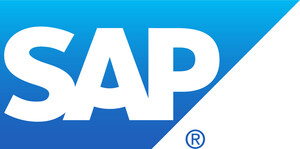WALLDORF, Germany, April 22, 2015 /PRNewswire/ -- Today's workforce is more connected, collaborative and dynamic than ever before. But these connections have created an unprecedented degree of workplace complexity that's adversely impacting business success, according to the Simplifying the Future of Work survey from Knowledge@Wharton and SAP SE (NYSE: SAP). The announcement was made at the SAP Forum for Human Resources Management 2015 being held April 21–22 in Stuttgart, Germany.
The survey found that corporate inertia, lack of clear prioritization from top management and underutilized technology solutions are the reasons for a jarring disconnect between what companies say and what they actually do about business simplification. While simplifying business is a growing strategic imperative for today's companies, many leaders are not aligning their actions effectively with their stated goals of simplifying business processes, decision making and technology. The study also outlined several ways that companies can make simplification more effective including self-diagnosis, support of senior leadership and driving change from the bottom up with regular updates.
The study was commissioned by SAP and conducted by Knowledge@Wharton, the online business analysis journal of the Wharton School at the University of Pennsylvania. Based on nearly 700 respondents at companies across industries, geographies and sizes, the findings were supplemented by interviews with Wharton professors and SAP executives.
The research outlined the broader factors behind workplace complexity:
Complexity is widespread
Nearly three-quarters (74 percent) of all respondents cited that process and decision-making complexities have inhibited their ability to meet business goals. This problem becomes more pervasive among top management, as only 27 percent of respondents believe that senior leaders take day-to-day actions designed to simplify business.
Technology has not helped to solve the whole problem. Sixty percent of respondents felt that technology was limiting their ability to meet strategic goals. Technology's lack of effectiveness is due to its lower priority to businesses, as only 39 percent of respondents say they have simplified technology within their organization.
"HR leaders must refresh strategies, streamline processes and embrace new technologies to focus on long-term growth," said Stefan Ries, chief human resources officer at SAP. "Companies should no longer accept inefficiencies, but challenge the complexities that increasingly permeate today's workplaces. Simplifying is the new imperative."
Simple is strategic
The majority of senior leaders believe business simplicity is beneficial, with over two-thirds (67 percent) saying that it will be very important in the next three years. Furthermore, 42 percent of respondents are optimistic that efforts to simplify business will be strongly effective in three years.
Respondents also believe that technology will be a key enabler in reducing complexity. In three years, they expect a 165 percent growth in leaders' ability to access information through self-service tools, supporting quicker decision making. The most desired technologies to improve simplification include:
- More efficient talent management and performance tools
- Deeper insights and analytics, to assess the effect of leadership
- Comprehensive learning and development processes
- Collaboration tools for engaging employees and having leadership discussions
"The first way to reduce complexity is to devote serious time and resources to solving the problem," said Morris Cohen, a professor of Operations and Information Management at the Wharton School. "These results show the lack of attention that complexity has received. This lack of attention cannot continue any longer."
To learn more about the global results of the simplification study, visit http://blogs.sap.com/innovation/executive-research/business-simplification-2015-the-unmet-strategic-imperative.
For more information, visit the SAP News Center. Follow SAP on Twitter at @sapnews.
About the Wharton School and Knowledge@Wharton
Founded in 1881 as the first collegiate business school, the Wharton School of the University of Pennsylvania is recognized globally for intellectual leadership and ongoing innovation across every major discipline of business education. With a broad global community and one of the most published business school faculties, Wharton creates economic and social value around the world. The School has 5,000 undergraduate, MBA, executive MBA, and doctoral students; more than 9,000 participants in executive education programs annually and a powerful alumni network of 93,000 graduates.
Knowledge@Wharton is the online business analysis journal of the Wharton School of the University of Pennsylvania. The site, which is free, captures relevant knowledge generated at Wharton and beyond by offering articles and videos based on research, conferences, speakers, books and interviews with faculty and other experts on global business topics.
Media Contact:
Bri Vellis, SAP, +1 (650) 645-2544, [email protected], PDT
Any statements contained in this document that are not historical facts are forward-looking statements as defined in the U.S. Private Securities Litigation Reform Act of 1995. Words such as "anticipate," "believe," "estimate," "expect," "forecast," "intend," "may," "plan," "project," "predict," "should" and "will" and similar expressions as they relate to SAP are intended to identify such forward-looking statements. SAP undertakes no obligation to publicly update or revise any forward-looking statements. All forward-looking statements are subject to various risks and uncertainties that could cause actual results to differ materially from expectations. The factors that could affect SAP's future financial results are discussed more fully in SAP's filings with the U.S. Securities and Exchange Commission ("SEC"), including SAP's most recent Annual Report on Form 20-F filed with the SEC. Readers are cautioned not to place undue reliance on these forward-looking statements, which speak only as of their dates.
Logo - http://photos.prnewswire.com/prnh/20110126/AQ34470LOGO
SOURCE SAP SE
Related Links
WANT YOUR COMPANY'S NEWS FEATURED ON PRNEWSWIRE.COM?
Newsrooms &
Influencers
Digital Media
Outlets
Journalists
Opted In




Share this article